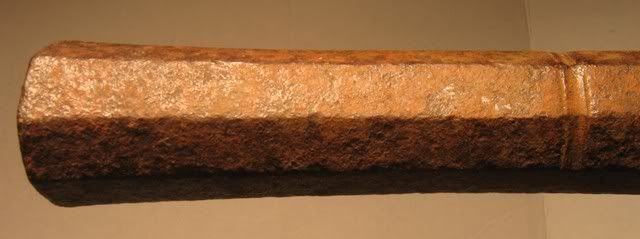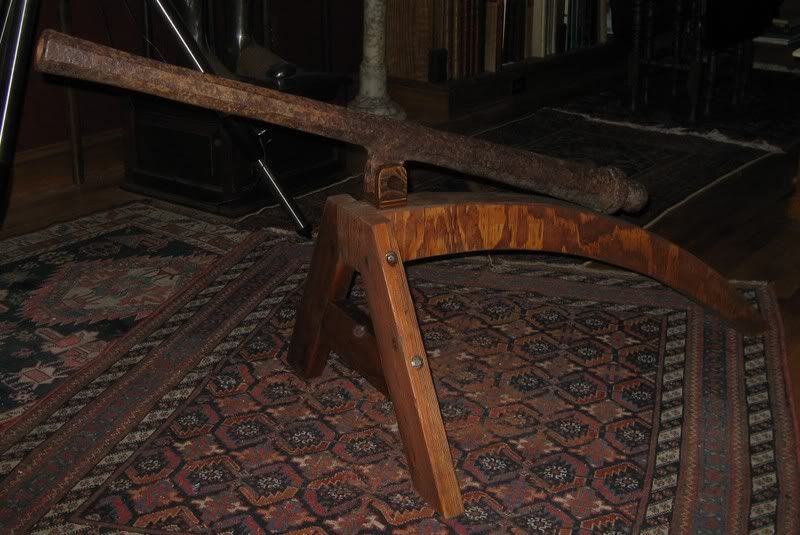
 |
|
|
|
|
#1 |
|
Member
Join Date: Feb 2005
Posts: 237
|
Last year I saw this cannon tube on ebay, of all places.
The description was to the effect that it- -was French -might be a signal cannon -was "at least from the 19th c., perhaps later" Now, this was not an area of close study for me but the lanky profile of this weapon said "earlier" earlier like 16th c. I really had no idea. I prevailed in the auction and won the piece for around $1900 (!). it's statistics are: Length 45" Depth of bore 40" Bore 1.25 " Weight 38.5 lbs     As fortune would have it, I had recently made the acquaintance of Matchlock (not his real name  ) thru the sainted Klaus Leibnitz (more on him in a bit) and had obtained and shipped off a pattern for the casting of accurate copies of the Loshult Gun (more later) for a project that Matchlock was pursuing in Germany. Old Matchlock is a world class authority on early firearms and I submitted it to him for his opinion. ) thru the sainted Klaus Leibnitz (more on him in a bit) and had obtained and shipped off a pattern for the casting of accurate copies of the Loshult Gun (more later) for a project that Matchlock was pursuing in Germany. Old Matchlock is a world class authority on early firearms and I submitted it to him for his opinion.I'll let him pick the story up from here. |
|
|

|
|
|
#2 | |
|
(deceased)
Join Date: Sep 2008
Location: Bavaria, Germany - the center of 15th and 16th century gunmaking
Posts: 4,310
|
Quote:
Oh Ed, Thank you so much for your most kind introduction but the truth is that your range of knowlegde is much wider than mine could possibly be, specializing on such a small and rarely plowed field as I have chosen to turn to almost 30 years ago: earliest European arsenal hand firearms and accouterments from the beginning (ca. 1330's) to ca. 1650. Now let us share with the community what I found out about your cannon barrel: Congratulations! It is almost certainly of South German origin and, as the two-stage form with its prolonged muzzle head clearly indicates, was wrought in about 1540. For stylistc comparison I attach two details of the barrel of my Nuremberg matchlock harquebus dated 1539 (more on that piece in my post on matchlock harquebuses earlier today): you can see the same two-stage style featuring the pronounced, staged long forward section, i.e. the muzzle head. Rarely enough, your beautiful piece retains considerable remains of its original minium (red lead) paint, which, in late Gothic and early Renaissance, was applied not only as an anti-rust protection but simultaneously reflected the period taste for the colors red and green in all arts and crafts alike. In order to get an idea of how colorful arsenal firearms of ca. 1500 actually looked, see katana's reply of Sept. 5 - thank you, katana! - to Ed's Early Hand Cannon post, showing water colors by Jörg Kölderer, Innsbruck, who illustrated the Maximilianische Zeugbücher after the original pieces in the various arsenals of the Holy Roman Emperor Maximilian I. from ca. 1507 to 1511. I am enclosing three more. Sad enough, almost every trace of original color has got rubbed off the very few surviving 500 year old examples preserved even in the most renowned museums, and this scandalos treatment mostly happened only in the 20th century. So listen, all ye museum curators and collectors: leave old, original surfaces of any piece alone! They are sacred! Imagine each generation before ours srubbing the pieces 'bright' again and again - what poor remains would have been left for us to see?! Which of us would be able to tell how pieces actually looked when they were furnished by the old armorers, with deep file marks on the iron surfaces? If iron parts show red (i.e. aggressive) rust nowadays, just apply some olive oil to them - exactly as the old arsenal curators used to do over the centuries! If the iron shows black (i.e. passive) rust - fine enough. Don't worry. The piece is in optimum state of preservation. Closely study the untouched, olive oil covered iron surfaces of the weapons preserved in the Graz arsenal in Styria/Austria and you will see that this light yellowish patina has proved to be the best possible surface protection for centuries. Forget about modern curators' hystery about acid substances in olive oil destroying iron! The Graz weapons with their original 300 to 500 year old surfaces preserved in best possible condition prove them all wrong. Well, seems I have got carried away a bit but I strongly feel that this had to be said. Anyway - I am looking forward to receiving replies. Thanks again, Ed. Matchlock |
|
|
|

|
|
|
#3 |
|
Member
Join Date: Feb 2005
Posts: 237
|
Interestingly, shortly after this exchange the barrel below came up on Thomas del Mar:
 Dated 1553 
|
|
|

|
|
|
#4 | |
|
Member
Join Date: Feb 2005
Posts: 237
|
While Matchlock's opinion on ancient firearms is unassailable, he can often be found lying about himself.
Quote:
 Seriously, we are very fortunate to have him with us. |
|
|
|

|
|
|
#5 |
|
Member
Join Date: Feb 2005
Posts: 237
|
Finally ... after some thought I made a mount that is "in the style of" the 16th c.
  and so it is currently displayed. |
|
|

|
|
|
#6 |
|
(deceased)
Join Date: Sep 2008
Location: Bavaria, Germany - the center of 15th and 16th century gunmaking
Posts: 4,310
|
I would like to add a few detailed images of the bronze cannon barrel dated 1553 from Tom Del Mar's London sale that Ed posted.
Actually, there was a pair of barrels in that lot, one of them heavily damaged. Please note the significant staging of the barrels, the inscription ANNO DOMI/NI and the date 1553, plus an owner's coat-of-arms, all cast and chiseled in high relief. The prolongated muzzle head closely corresponds to Ed's iron barrel of ca. 1540, although bronze barrels usually follow a more refined style scheme. Matchlock |
|
|

|
|
|
#7 |
|
Member
Join Date: Feb 2005
Posts: 237
|
They didn't sell, did they?
You know what happened to them? |
|
|

|
 |
|
|